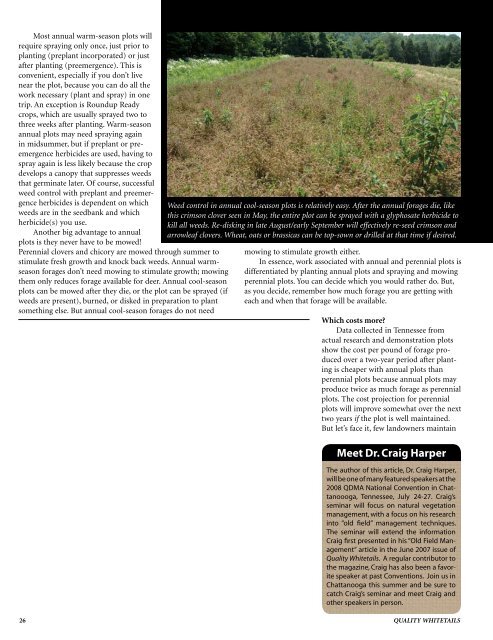Create successful ePaper yourself
Turn your PDF publications into a flip-book with our unique Google optimized e-Paper software.
Most annual warm-season plots will<br />
require spraying only once, just prior to<br />
planting (preplant incorporated) or just<br />
after planting (preemergence). This is<br />
convenient, especially if you don’t live<br />
near the plot, because you can do all the<br />
work necessary (plant and spray) in one<br />
trip. An exception is Roundup Ready<br />
crops, which are usually sprayed two to<br />
three weeks after planting. Warm-season<br />
annual plots may need spraying again<br />
in midsummer, but if preplant or preemergence<br />
herbicides are used, having to<br />
spray again is less likely because the crop<br />
develops a canopy that suppresses weeds<br />
that germinate later. Of course, successful<br />
weed control with preplant and preemergence<br />
herbicides is dependent on which<br />
weeds are in the seedbank and which<br />
herbicide(s) you use.<br />
Another big advantage to annual<br />
plots is they never have to be mowed!<br />
Perennial clovers and chicory are mowed through summer to<br />
stimulate fresh growth and knock back weeds. Annual warmseason<br />
forages don’t need mowing to stimulate growth; mowing<br />
them only reduces forage available for deer. Annual cool-season<br />
plots can be mowed after they die, or the plot can be sprayed (if<br />
weeds are present), burned, or disked in preparation to plant<br />
something else. But annual cool-season forages do not need<br />
Weed control in annual cool-season plots is relatively easy. After the annual forages die, like<br />
this crimson clover seen in May, the entire plot can be sprayed with a glyphosate herbicide to<br />
kill all weeds. Re-disking in late August/early September will effectively re-seed crimson and<br />
arrowleaf clovers. Wheat, oats or brassicas can be top-sown or drilled at that time if desired.<br />
mowing to stimulate growth either.<br />
In essence, work associated with annual and perennial plots is<br />
differentiated by planting annual plots and spraying and mowing<br />
perennial plots. You can decide which you would rather do. But,<br />
as you decide, remember how much forage you are getting with<br />
each and when that forage will be available.<br />
Which costs more?<br />
Data collected in Tennessee from<br />
actual research and demonstration plots<br />
show the cost per pound of forage produced<br />
over a two-year period after planting<br />
is cheaper with annual plots than<br />
perennial plots because annual plots may<br />
produce twice as much forage as perennial<br />
plots. The cost projection for perennial<br />
plots will improve somewhat over the next<br />
two years if the plot is well maintained.<br />
But let’s face it, few landowners maintain<br />
Meet Dr. Craig Harper<br />
The author of this article, Dr. Craig Harper,<br />
will be one of many featured speakers at the<br />
2008 QDMA National Convention in Chattanoooga,<br />
Tennessee, July 24-27. Craig’s<br />
seminar will focus on natural vegetation<br />
management, with a focus on his research<br />
into “old field” management techniques.<br />
The seminar will extend the information<br />
Craig first presented in his “Old Field Management“<br />
article in the June 2007 issue of<br />
Quality Whitetails. A regular contributor to<br />
the magazine, Craig has also been a favorite<br />
speaker at past Conventions. Join us in<br />
Chattanooga this summer and be sure to<br />
catch Craig’s seminar and meet Craig and<br />
other speakers in person.<br />
26 QUALITY WHITETAILS




